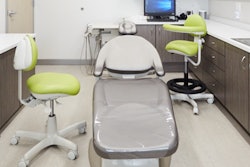
SAN FRANCISCO - Technology is slowly but surely changing the practice of dentistry, whether we like it or not.
The key is to make informed buying decisions and have a clear plan for incorporating these new devices and processes into your practice, according to the Virtual Office Design panel held October 20 at the ADA Annual Session.
The session was moderated by Larry Emmott, DDS, founder and director of Emmott on Technology and a leading speaker and authority on the impact of technology in dentistry. Joining him on the panel was Claudio Levato, DDS, who has been practicing in the Chicago area since 1976 and first began computerizing his office in 1982, and Michael Unthank, DDS, a well-known architect who specializes in dental office design.
All three speakers emphasized that computerizing your office from the front desk to the operatory and beyond leads to more effective and efficient dentistry that patients appreciate.
“Technology validates quality.”
"Technology allows us to filter and organize the flow of information in a dental office," said Dr. Levato, who has spent the last 30 years creating a state-of-the-art practice that prides itself in delivering optimum patient care. "Technology validates quality. Technology facilitates same-day procedures. Technology let's you preplan to save chair time."
Dr. Levato's office features many of the latest hardware and software products and services, including Eaglesoft, Lighthouse 360, Transnet, LogMeIn, Tru-Align, MyRay, SkyView, Aribex, E4D Sky, radio headsets for internal communication, and dual medical-grade monitors with touchscreens in each operatory.
Even so, he believes that four key challenges still exist in the adoption of technology for many dentists:
- Software upgrades and inconsistencies
- Hardware incompatibilities
- Power outages
- Staff training
Dr. Emmott agreed, adding that it is critical to have a plan and a vision of what you want to accomplish as you begin to incorporate these products and services into your practice.
"Many dentists don't know what is possible so they buy random technology that may or may not be useful in their office," he said.
While he believes "the cloud" and software-as-service will play an increasingly important role in data management for dental practices, Dr. Emmott expressed concern that there has not been much discussion about the ethics of electronic health records and Internet-based data sharing.
"All this personal data will now be available in the cloud where anyone can get it," he said. "That is great, but it is also frightening. There are privacy issues, and that is what HIPAA is really all about."
The question of who owns the data is a related issue that needs to be addressed, Dr. Emmott added.
"When you own an e-book on Kindle, you own digital access, not the book or its content," he said. "With health records, it seems right that the patient should own the data, but that's not the way it works. The doctor creates and maintains that record and can buy and sell it if he sells the practice. And with electronic data, the software companies control our access to that data. So who owns the data? As a society, we have not adequately addressed these issues."
Dr. Unthank took the concept of "design" literally in his presentation, which showcased a number of award-winning dental office designs his company has created. He offered several "dos and don'ts" to the audience, from exterior signage -- "you do not need a tooth on your sign" -- to front-desk acoustics and bathroom fixtures.
"We are visual animals," he said. "How your office looks influences a patient's decision to go to you. It reflects your quality of service. It's another component of marketing."
For those doctors looking to build a new office from scratch, Dr. Unthank emphasized the need to define how you intend to practice and to build it on paper first -- "exhaustively" -- to avoid wasted square footage and practice inefficiencies.
Make sure to include a place for your team, a place for yourself, and to segregate these areas from areas where you will see patients, he added.
"It costs more to build it wrong than right," Dr. Unthank said.



















